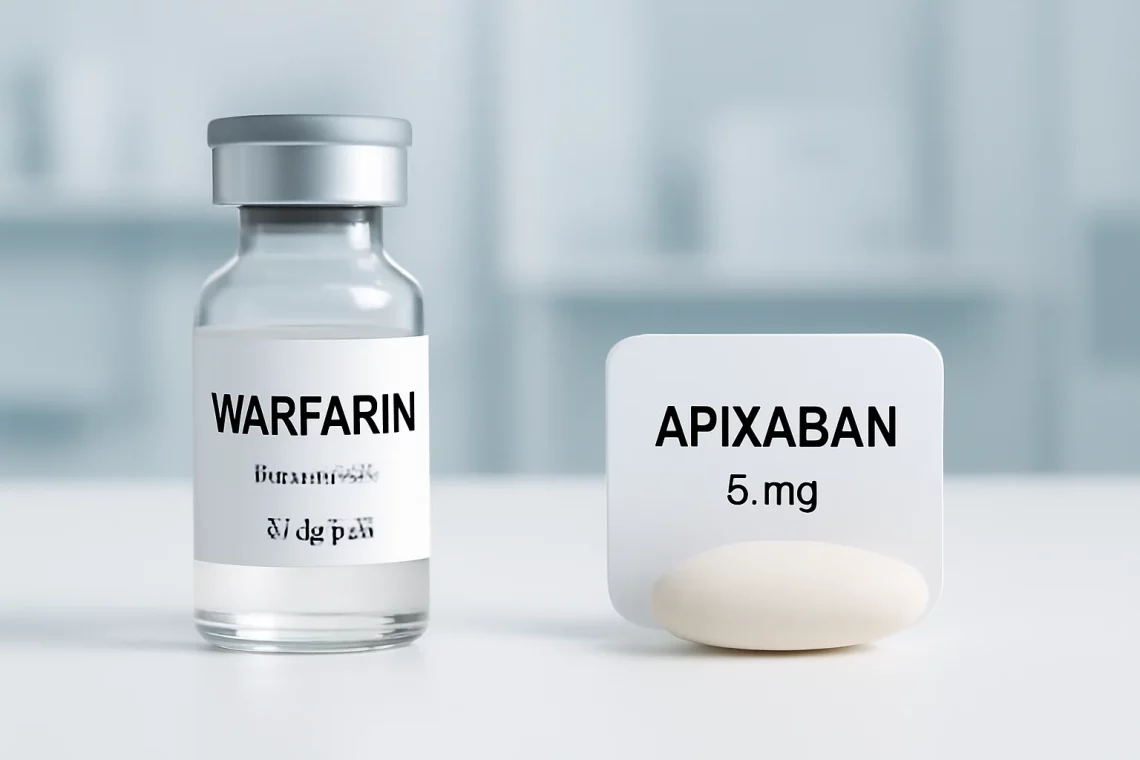
Warfarin or Apixaban: Choosing the Right Anticoagulant for You
The choice between Warfarin and Apixaban has become increasingly relevant in discussions surrounding anticoagulant therapy. As the prevalence of conditions such as atrial fibrillation and venous thromboembolism rises, understanding the nuances of these two medications is essential for both healthcare providers and patients. Anticoagulants play a crucial role in preventing blood clots, which can lead to serious health complications, including stroke and pulmonary embolism.
Warfarin, a traditional anticoagulant, has been used for decades and is known for its effectiveness, but it comes with certain dietary restrictions and requires regular monitoring of blood levels. In contrast, Apixaban is a newer medication that falls into the category of direct oral anticoagulants (DOACs). It offers the advantage of fixed dosing and less frequent monitoring, making it a more convenient option for many.
However, the differences extend beyond just ease of use. Factors such as patient-specific considerations, potential drug interactions, and the overall safety profiles of these medications must be carefully evaluated. In this article, we will delve deeper into the characteristics, benefits, and drawbacks of both Warfarin and Apixaban, providing a comprehensive overview for those navigating their anticoagulation options.
Understanding Warfarin: Mechanism and Use
Warfarin is a vitamin K antagonist that has been a cornerstone in anticoagulation therapy for many years. It works by inhibiting the synthesis of vitamin K-dependent clotting factors, which are essential for blood coagulation. By reducing these factors, Warfarin effectively decreases the blood’s ability to clot, thereby lowering the risk of thromboembolic events.
One of the key features of Warfarin therapy is the need for regular monitoring of the International Normalized Ratio (INR). This blood test measures how long it takes for blood to clot and helps to ensure that patients are within the therapeutic range. Maintaining the right INR level is crucial, as being too low increases the risk of clot formation, while being too high can lead to dangerous bleeding complications.
Diet plays a significant role in the management of patients on Warfarin. Foods rich in vitamin K, such as leafy greens, can influence the effectiveness of the medication. Patients are often advised to maintain a consistent intake of these foods to avoid fluctuations in INR levels. This dietary consideration can make Warfarin therapy challenging for some individuals, particularly those who enjoy a varied diet.
Moreover, Warfarin is known for its potential interactions with various medications, supplements, and even certain herbal products. As such, patients on Warfarin are typically required to have close follow-up with their healthcare provider to adjust dosing as needed based on their INR results and any other factors that may arise.
Despite these challenges, Warfarin remains a highly effective option for many patients, particularly those with mechanical heart valves or other specific indications where its use is well-established. Understanding the intricacies of Warfarin therapy is essential for both patients and healthcare professionals to ensure safe and effective anticoagulation management.
Exploring Apixaban: Benefits and Safety
Apixaban represents a newer class of anticoagulants known as direct oral anticoagulants (DOACs). Unlike Warfarin, which requires regular INR monitoring, Apixaban is characterized by its fixed dosing regimen that does not necessitate routine blood tests. This aspect alone has made it an appealing option for many patients, as it simplifies the management of anticoagulation therapy.
The mechanism of action for Apixaban involves direct inhibition of factor Xa, a key enzyme in the coagulation cascade. By inhibiting this factor, Apixaban effectively reduces thrombin generation, leading to a decreased likelihood of clot formation. This targeted approach allows for a more predictable anticoagulant effect, which is beneficial for patient management.
One of the primary advantages of Apixaban is its lower risk of major bleeding compared to traditional anticoagulants like Warfarin. Clinical trials have shown that Apixaban is associated with a reduced incidence of intracranial hemorrhage and gastrointestinal bleeding, making it a safer option for many patients, particularly the elderly or those with a history of bleeding complications.
Furthermore, Apixaban does not have the same dietary restrictions as Warfarin, allowing patients greater freedom in their food choices. This can significantly improve quality of life, as individuals are not required to monitor their vitamin K intake or make drastic changes to their eating habits.
However, it’s important to note that Apixaban is not suitable for everyone. Certain populations, such as those with severe renal impairment or those on specific medications that interact with Apixaban, may require alternative anticoagulation strategies. Therefore, a thorough assessment by a healthcare provider is critical to determine the most appropriate anticoagulant for each individual patient.
Overall, Apixaban offers a modern approach to anticoagulation therapy, with benefits that cater to the needs of many patients. Its effectiveness, ease of use, and favorable safety profile make it a strong contender in the realm of anticoagulant medications.
Comparing Efficacy and Safety Profiles
When considering Warfarin and Apixaban, it is essential to compare their efficacy and safety profiles to determine which medication may be more suitable for a given patient. Both anticoagulants are effective in preventing thromboembolic events, but their outcomes can differ based on specific patient factors and clinical scenarios.
Clinical trials have demonstrated that Apixaban is as effective as Warfarin in reducing the risk of stroke and systemic embolism in patients with atrial fibrillation. In some studies, Apixaban has even shown superior outcomes in terms of bleeding risk, particularly in patients at higher risk for major bleeding events. This finding is particularly relevant for elderly patients or those with multiple comorbidities.
Warfarin’s long-standing history means that it has a wealth of clinical experience and data supporting its use. However, its effectiveness is heavily reliant on patient adherence to monitoring protocols and dietary restrictions. In contrast, the predictable pharmacokinetics of Apixaban offer a more straightforward approach to anticoagulation, allowing for fixed dosing without the need for frequent monitoring.
Another critical aspect of the comparison is the potential for drug interactions. Warfarin is notorious for its numerous interactions with various medications, which can complicate therapy and necessitate ongoing adjustments. On the other hand, while Apixaban also has potential interactions, its profile is generally considered simpler, making it easier for healthcare providers to manage.
Ultimately, the choice between Warfarin and Apixaban should be guided by a thorough evaluation of the patient’s medical history, risk factors, and preferences. Shared decision-making between the patient and healthcare provider is crucial to ensure that the selected anticoagulant aligns with the patient’s lifestyle and health goals.
Patient Considerations and Lifestyle Factors
When choosing between Warfarin and Apixaban, several patient-specific considerations and lifestyle factors come into play. These factors can significantly influence the effectiveness and safety of anticoagulation therapy, making it vital for healthcare providers to engage in comprehensive discussions with their patients.
One of the most important considerations is the patient’s ability to adhere to the treatment plan. Warfarin requires regular INR monitoring, which can be a barrier for some patients, particularly those with mobility issues or those living in remote areas. For these individuals, Apixaban’s fixed dosing and lack of routine blood tests may be more appealing and practical.
Additionally, a patient’s dietary habits can impact their anticoagulation therapy. Those who enjoy a varied diet rich in vitamin K may find it challenging to maintain stable INR levels on Warfarin. Conversely, Apixaban’s lack of dietary restrictions can provide greater flexibility and enhance patient satisfaction.
Patients’ preferences regarding treatment administration also play a crucial role. Warfarin is typically taken once daily, while Apixaban can be taken twice daily in some cases. Understanding a patient’s routine and their preferences for medication schedules can help healthcare providers tailor their recommendations appropriately.
Furthermore, potential drug interactions must be considered. Patients taking multiple medications or those with complex medical histories may benefit from the simpler interaction profile of Apixaban. However, it is essential for healthcare providers to conduct a thorough medication review to determine the safest and most effective option for each individual.
In conclusion, the choice between Warfarin and Apixaban is not one-size-fits-all. Each patient presents unique circumstances that must be carefully evaluated to ensure optimal anticoagulation management. By considering patient preferences, lifestyle factors, and potential interactions, healthcare providers can make more informed decisions that enhance patient outcomes.
**Disclaimer:** This article is not intended as medical advice. Individuals should always consult their healthcare provider for guidance regarding their specific health conditions and treatment options.




